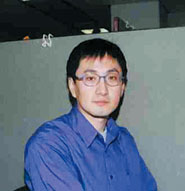
 |

|
HARAYAMA Takahisa Adaptive Communications Research Laboratories |
|
Advances in processing technology have made it possible to create new types of 2D microcavity lasers with potential applications as key components in optical wireless communications and optical integrated circuits. 1. Introduction 2. Conventional lasers |
||
 Fig. 1 .Typical 1D laser cavity. |
3. 2D Microcavity lasers We have proposed the use of 2D resonant cavities for lasers. All of the edges of these new types of lasers are mirrors, so output light is emitted in two dimensions. Advances in processing technology, such as quantum-well structures and dry-etching techniques, have made it possible to create these new types of 2D microcavity lasers. 4. Microstadium lasers [1] It is important to note that the efficiency of light confinement by a 2D resonant cavity strongly depends on its 2D shape. If laser action could occur in the 2D resonant cavities of arbitrary shapes, it would be possible to design the 2D shape of the cavity in such a way as to make the emission pattern of the laser light appropriate for specific applications. We have investigated, both theoretically and experimentally, 2D microcavity lasers with a stadium shape, which is one of the most difficult shapes for observation of laser action. Here, we explain the reason why lasing in microstadium lasers is so difficult. Two types of ray-dynamical trajectories are depicted in Figure 2. The blue line corresponds to the periodic orbit bouncing back and forth, while the red lines denote the chaotic ray-dynamical trajectory starting from the initial condition, which is very close to the blue one. One can see that the red trajectory departs from the blue one after several collisions with the edge of the stadium cavity and then becomes a highly complex ray-dynamical trajectory. Light can be efficiently confined inside the cavity due to total internal reflection as long as the incident angles of the ray-dynamical trajectory on the edge of the cavity are larger than the critical angle. However, chaotic ray-dynamical trajectories in microstadium lasers violate the critical angle condition and prohibit efficient light confinement due to their total internal reflection. Consequently, it is very difficult to confine light inside the microstadium lasers efficiently enough for lasing. Nevertheless, we have shown both theoretically and experimentally that sufficient optical confinement for the onset of stable lasing can be obtained in microstadium lasers. One of the theoretically predicted lasing patterns and a photo of a microstadium laser diode taken by a scanning electron microscope are shown in Figure 3. Note that the actual microstadium cavity is finely formed by a reactive-ion-etching technique to achieve walls with sufficiently smooth curves and verticalness. |
|
5. Locking of two modes [2] We found an asymmetric stationary lasing pattern as shown in Figure 4 in microstadium lasers. Conventional 1D lasers never show such asymmetry. The asymmetric stationary lasing pattern in Figure 4 consists of two modes belonging to different symmetry classes, as shown in Figure 5. The interaction between the two modes through an active lasing medium results in the typical nonlinear phenomenon of the "locking of two modes," which breaks the symmetry of lasing patterns in a symmeteric microstadium cavity. |
|
6. Quasi-stadium lasers [3〜5] If a stadium cavity is stretched lengthways along its straight edges, then one can obtain a slender stadium cavity, which is called a quasi-stadium cavity. Quasi-stadium lasers have both the lasing characteristics of 2D microcavity lasers and strong directionality like 1D lasers. Therefore, the quasi-stadium lasers are more practical for actual applications. For example, we found a pair of lasing modes that are applicable to an optical switch. |
 Fig. 6. A pair of lasing modes in a quasi-stadium laser: (a) axis mode, and (b) ring-trajectory mode. |
7. Control of resonance modes We succeeded in controlling the laser action in the two modes in Figure 6 by using the injection current patterns. In addition, locking of two modes is observed in quasi-stadium lasers. These control methods for resonance modes might be able to realize a non-mechanical switch for the direction of the output laser light. Therefore, 2D microcavity lasers can become key devices for optical sources and switches for integrated optical circuits as well as optical wireless networks. 8. Discussion References
[1] T. Harayama, P. Davis, and K. S. Ikeda, "Stable Oscillations of a Spatially Chaotic Wave Function in a Microstadium Laser", Phys. Rev. Lett. 90, 063901-1-4 (2003). |